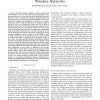Free Online Productivity Tools
i2Speak
i2Symbol
i2OCR
iTex2Img
iWeb2Print
iWeb2Shot
i2Type
iPdf2Split
iPdf2Merge
i2Bopomofo
i2Arabic
i2Style
i2Image
i2PDF
iLatex2Rtf
Sci2ools
116
Voted
INFOCOM
2010
IEEE
2010
IEEE
Maximum Damage Malware Attack in Mobile Wireless Networks
—Malware attacks constitute a serious security risk that threatens to slow down the large scale proliferation of wireless applications. As a first step towards thwarting this security threat, we seek to quantify the maximum damage inflicted on the system owing to such outbreaks and identify the most vicious attacks. We represent the propagation of malware in a batteryconstrained mobile wireless network by an epidemic model in which the worm can dynamically control the rate at which it kills the infected node and also the transmission range and/or the media scanning rate. At each moment of time, the worm at each node faces the following trade-offs: (i) using larger transmission range and media scanning rate to accelerate its spread at the cost of exhausting the battery and thereby reducing the overall infection propagation rate in the long run or (ii) killing the node to inflict a large cost on the network, however at the expense of loosing the chance of infecting more susceptible ...
Communications | Infection Propagation Rate | INFOCOM 2010 | Media Scanning Rate | Transmission Range |
Related Content
| Added | 28 Jan 2011 |
| Updated | 28 Jan 2011 |
| Type | Journal |
| Year | 2010 |
| Where | INFOCOM |
| Authors | M. H. R. Khouzani, Saswati Sarkar, Eitan Altman |
Comments (0)

